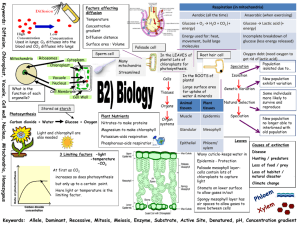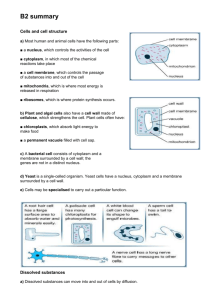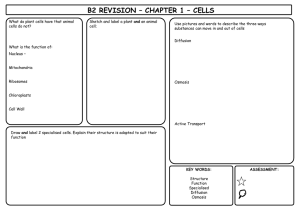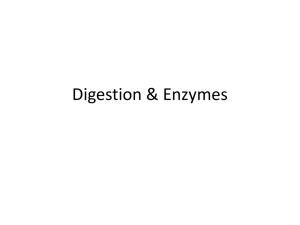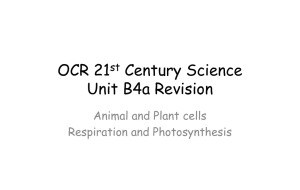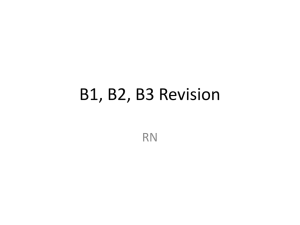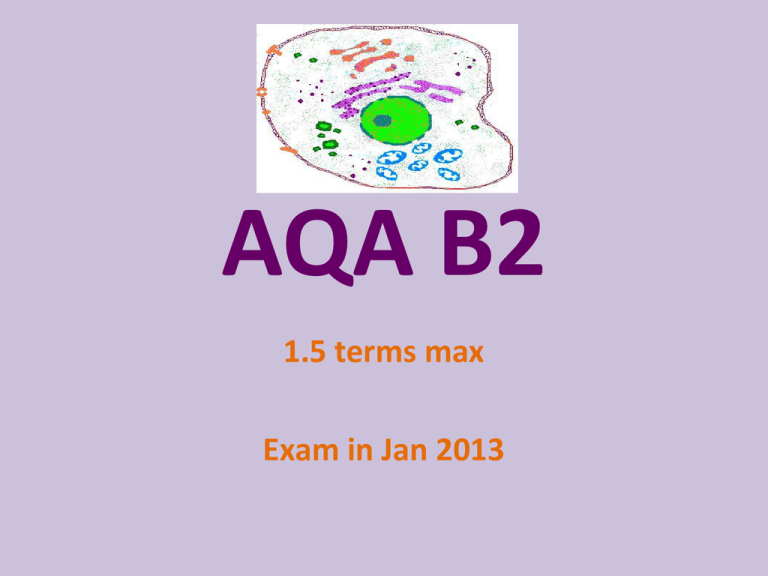
AQA B2
1.5 terms max
Exam in Jan 2013
Guide timings
•
•
•
•
•
•
Cells
Diffusion
Organs & Tissues
Digestive System
B1 revision and exam
Photosynthesis ISA
•
•
•
•
•
•
•
Photosynthesis re-cap 2
Distribution of organisms 2 SEPT
Proteins (enzymes) 3
Respiration 3
Cell division 3
Genetics 3
Speciation 2
HALF TERM
EASTER
All living things are made up of cells.
Animal and Plant Cells
What else do we have to add?
Yeast and Bacteria
Complete the table comparing 4 cell
types
Cell part
nucleus
cell membrane
cell wall
cytoplasm
vacuole
mitochondria
chloroplasts
ribosomes
Animal cell
Plant cell
Bacteria cell
Yeast cell
Name the cell……
• Cell A has a cell membrane and a cell wall and its
genes aren’t in a distinct nucleus
• Cell B has a cell wall containing cellulose and a
permanent vacuole
• Cell C has a nucleus, cell membrane and a cell
wall
• Cell D has no cell wall.
Specialised cells……
• Relate structure to function
Dissolved Substances
• Move by diffusion
low conc
high conc
Diffusion
• Diffusion is the spreading of the …………….. of a
gas, or of any substance in ………………..,
resulting in a ……… movement from a region
where they are of a ……………… concentration
to a region with a ……………. concentration.
• The greater the ………………… in concentration,
the ………………. the rate of diffusion.
Diffusion of Oxygen
What is the
name of the
process that
happens in
all living cells
and uses
oxygen?
How is the rate of oxygen diffusion
maximised here?
Organisation
• Cells
• Tissues
• Organs
• Organ systems
• Organism
Tissues
• Muscular
• Glandular
• Epithelial
Stomach Tissues
The Stomach
Digestive System
• glands, such as the pancreas and
salivary glands, which produce
digestive juices
• the stomach and small intestine,
where digestion occurs
• the liver, which produces bile
• the small intestine, where the
absorption of soluble food occurs
• the large intestine, where water is
absorbed from the undigested
food, producing faeces.
Plant Organs & Tissues
Photosynthesis
Photosynthesis
Write the word equation
_______
_____+_____ _____+_____
_______
How do you measure the rate?
What is the tank of water for?
• Green plants and algae photosynthesise.
• They both contain chlorophyll.
• This is a green substance which absorbs light
energy.
Limiting factors
• Light
• Carbon dioxide
What would the
ideal conditions be
in a greenhouse?
• Temperature
What are the disadvantages
of growing food in
greenhouses?
What is the glucose used for?
1. Stored as starch: glucose may be converted into insoluble starch for
storage.
2. Respiration: plant cells use some of the glucose for respiration.
3. Making new substances: some glucose in plants and algae is used
■ to produce fat or oil for storage
■ to produce cellulose, which strengthens the cell wall
■ to produce proteins.
To produce proteins, plants also use nitrate ions that are absorbed
from the soil.
Effect of light
on starch
stored in leaf
Starch test on a leaf
Distribution of organisms
Physical factors that may affect organisms are:
■ temperature
■ availability of nutrients
■ amount of light
■ availability of water
■ availability of oxygen and carbon dioxide.
Measuring distribution
Quantitative data can be obtained by:
■ random sampling with quadrats.
■ sampling along a transect.
Belt transect
• Looking at change along a line e.g. along a
river bank, beach, hillside….
Quadrats : random sampling
Sample Size
• Number of quadrats over what size area?
Valid
Need to consider what a
reasonable and valid sample size
would be.
and
Reproducible
What is reasonable in terms of
time/cost. Could it be done again?
Mean, Median, Mode
• Mean:
add up and divide by how
many
• Median:
put in order and find the
middle one
• Mode: most frequent one
2, 5, 8, 3, 5, 4,
8, 9, 2, 1, 1, 6,
7, 8, 6, 3, 5, 2,
8, 7, 8, 2, 8, 1,
9, 4, 3, 5, 4, 7
Proteins
• Protein molecules are made
up of long chains of amino
acids.
• These long chains are folded
to produce a specific shape
that enables other molecules
to fit into the protein.
Folded into specific shape……..
Proteins act as…..
■ structural components of tissues such as muscles
■ hormones
■ antibodies
■ catalysts
(enzymes)
• Catalysts increase the rate of
chemical reactions.
• Biological catalysts are called
enzymes.
• Enzymes are proteins.
The shape of an enzyme is vital
for the enzyme’s function.
Effect of temperature
• High temperatures change the shape.
(denature)
Digestive enzymes
The digestive enzymes are
produced by specialized cells in
glands and in the lining of the
gut.
The enzymes then pass out of
the cells into the gut where
they come into contact with
food molecules.
They catalyse the breakdown of
large molecules into smaller
molecules.
Different enzymes work
best at different pH values
• Stomach pH ?
• Mouth pH ?
• Intestine pH ?
The stomach also produces hydrochloric acid.
The enzymes in the stomach work most
effectively in these acid conditions.
• The liver produces
bile, which is stored
in the gall bladder
before being released
into the small
intestine.
• Bile neutralises the
acid that was added
to food in the
stomach. This
provides alkaline
conditions in which
enzymes in the small
intestine work most
effectively.
Bile
1. The enzyme amylase is produced in the salivary glands, the
pancreas and the small intestine. This enzyme catalyses the
breakdown of starch into sugars in the mouth and small
intestine.
2. Protease enzymes are produced by the stomach, the
pancreas and the small intestine. These enzymes catalyse the
breakdown of proteins into amino acids in the stomach and
the small intestine.
3. Lipase enzymes are produced by the pancreas and small
intestine. These enzymes catalyse the breakdown of lipids
(fats and oils) into fatty acids and glycerol in the small
intestine.
• Some
microorganisms
produce enzymes
that pass out of the
cells.
• These enzymes have
many uses in the
home and in
industry.
Enzymes in the home
■ biological detergents
may contain proteindigesting and fatdigesting enzymes
(proteases and lipases)
■ biological detergents
are more effective at
low temperatures than
other types of
detergents.
Industry
■ proteases are used to ‘pre-digest’
the protein in some baby foods
■ carbohydrases are used to convert
starch into sugar syrup
■ isomerase is used to convert
glucose syrup into fructose syrup,
which is much sweeter and therefore
can be used in smaller quantities in
slimming foods.
In industry, enzymes are used to bring about
reactions at normal temperatures and pressures
that would otherwise require expensive, energydemanding equipment.
However, most enzymes are denatured at high
temperatures and many are costly to produce.
The chemical reactions inside cells are controlled by enzymes.
During aerobic respiration (respiration that uses oxygen)
chemical reactions occur that:
■ use glucose (a sugar) and oxygen
■ release energy.
Aerobic respiration takes place continuously in both
plants and animals.
Most of the reactions in aerobic respiration take place
inside mitochondria.
glucose + oxygen ➞ carbon dioxide + water (+ energy)
The energy may be used:
• in animals, to enable muscles to contract
• in mammals and birds, to maintain a steady body
temperature in colder surroundings
• to build larger molecules from smaller ones
• in plants, to build up sugars, nitrates and other
nutrients into amino acids which are then built up
into proteins.
Exercise
■ the heart rate increases
■ the rate and depth of breathing increases.
h) These changes increase the blood flow to the
muscles and so increase the supply of sugar and
oxygen and increase the rate of removal of
carbon dioxide.
i) Muscles store glucose as glycogen, which can then
be converted back to glucose for use during exercise.
Anaerobic respiration
a) During exercise, if insufficient oxygen is
reaching the muscles they use anaerobic
respiration to obtain energy.
b) Anaerobic respiration is the incomplete
breakdown of glucose and produces lactic acid.
Oxygen debt
•
•
•
•
•
•
•
•
•
•
•
•
As the breakdown of glucose is incomplete,
much less energy is released than during
aerobic respiration. Anaerobic respiration
results in an oxygen debt that has to be
repaid in order to oxidise lactic acid to
carbon dioxide and water.
d) If muscles are subjected to long periods of vigorous
activity they become fatigued, ie they stop contracting
efficiently. One cause of muscle fatigue is the build-up
of lactic acid in the muscles. Blood flowing through
the muscles removes the lactic acid.
Sexual reproduction gives rise to variation because,
when gametes fuse, one of each pair of alleles
comes from each parent.
•
• b) In human body cells, one of the 23 pairs of
• chromosomes carries the genes that determine
• sex. In females the sex chromosomes are the
• same (XX); in males the sex chromosomes are
• different (XY).
Genes & alleles
•
c) Some characteristics are controlled by a single
gene. Each gene may have different forms called alleles.
d) An allele that controls the development of a
characteristic when it is present on only one
of the chromosomes is a dominant allele.
e) An allele that controls the development of
characteristics only if the dominant allele is
not present is a recessive allele.
Fertilisation
• When gametes join at fertilisation, a single
body cell with new pairs of chromosomes is
formed.
• A new individual then develops by this cell
repeatedly dividing by mitosis.
DNA
•
•
•
•
•
•
•
•
•
•
•
•
Chromosomes are made up of large molecules
of DNA (deoxyribonucleic acid) which has a double helix structure.
g) A gene is a small section of DNA.
h) Each gene codes for a particular combination
of amino acids which make a specific protein.
Additional guidance:
3
i) Each person (apart from identical twins) has unique DNA. This can be
used to identify
• individuals in a process known as DNA fingerprinting.
Mitosis
•
•
•
•
•
•
•
•
•
•
•
•
•
B2.7.1 Cell division
a) In body cells the chromosomes are normally found
in pairs. Body cells divide by mitosis.
d) Mitosis occurs during growth or to produce
b) The chromosomes
contain the genetic information.
replacement cells.
c) When a body cell divides by mitosis:
■ copies of the genetic material are made
■ then the cell divides once to form two
genetically identical body cells.
Asexual
• The cells of the offspring produced by asexual
• reproduction are produced by mitosis from
the parental cells. They contain the same
alleles as the parents.
Meiosis
•
•
•
•
•
•
•
•
•
•
•
•
•
•
•
•
Body cells have two sets of chromosomes;
sex cells (gametes) have only one set.
f) Cells in reproductive organs – testes and ovaries in humans – divide to form gametes.
g) The type of cell division in which a cell divides to
form gametes is called meiosis.
h) When a cell divides to form gametes:
■ copies of the genetic information are made
■ then the cell divides twice to form four
gametes, each with a single set of
chromosomes.
crosses
•
Candidates should use their skills, knowledge and understanding to:
■ explain why Mendel proposed the idea of separately inherited factors and why the importance of this discovery was not recognised until after his death
■ interpret genetic diagrams, including family trees
■ construct genetic diagrams of monohybrid
crosses and predict the outcomes of
monohybrid crosses and be able to use the
terms homozygous, heterozygous, phenotype
and genotype
■ predict and/or explain the outcome of crosses
between individuals for each possible combination
of dominant and recessive alleles of the same gene
Mendel
• Candidates should be familiar with principles
used by Mendel in investigating monohybrid
inheritance in peas.
• They should understand that Mendel’s work
preceded the work by other scientists which
linked Mendel’s ‘inherited factors’ with
chromosomes.
Genetic Disorders
•
•
•
•
•
•
•
•
•
•
•
•
•
•
•
•
•
•
•
•
Genetic disorders
a) Some disorders are inherited.
b) Polydactyly – having extra fingers or toes – is caused
by a dominant allele of a gene and can therefore
be passed on by only one parent who has the disorder.
c) Cystic fibrosis (a disorder of cell membranes) must be inherited from both parents. The parents may be carriers
of the disorder without actually having the disorder themselves.
It is caused by a recessive allele of a gene and can therefore be passed on by parents, neither of whom has the
disorder.
d) Embryos can be screened for the alleles that cause these and other genetic disorders.
Stem cells
•
•
•
•
•
•
•
•
•
•
•
•
•
•
Most types of animal cells differentiate at an early
stage whereas many plant cells retain the ability to
differentiate throughout life. In mature animals, cell
division is mainly restricted to repair and replacement.
A k) Cells from human embryos and adult bone marrow,
called stem cells, can be made to differentiate into
many different types of cells, eg nerve cells.
l) Human stem cells have the ability to develop into
any kind of human cell.
m) Treatment with stem cells may be able to help
conditions such as paralysis.
ethics
■ make informed judgements about the social and
ethical issues concerning the use of stem cells
from embryos in medical research and treatments
■ make informed judgements about the economic,
social and ethical issues concerning embryo
screening.
Fossils
a) Evidence for early forms of
life comes from fossils.
b) Fossils are the ‘remains’ of
organisms from many years
ago, which are found in rocks.
c) We can learn from fossils
how much or how little
different organisms have
changed as life developed on
Earth.
How are Fossils formed?
■ from the hard parts of animals that do not
decay easily
■ from parts of organisms that have not decayed because one
or more of the conditions needed for decay are absent
■ when parts of the organism are replaced by other materials
as they decay
■ as preserved traces of organisms, eg footprints, burrows
and rootlet traces.
c) Many early forms of life were soft-bodied,
which means that they have left few traces
behind.
What traces there were have been mainly
destroyed by geological activity.
Extinction may be caused by:
■ changes to the environment over geological time
■ new predators
■ new diseases
■ new, more successful, competitors
■ a single catastrophic event, eg massive volcanic
eruptions or collisions with asteroids
■ through the cyclical nature of speciation.
New Species
New species arise as a result of: isolation – two populations of a
species become separated, eg geographically
■ genetic variation – each population has a
wide range of alleles that control their
characteristics
■ natural selection – in each population, the
alleles that control the characteristics which
help the organism to survive are selected
■ speciation – the populations become so
different that successful interbreeding
is no longer possible.

